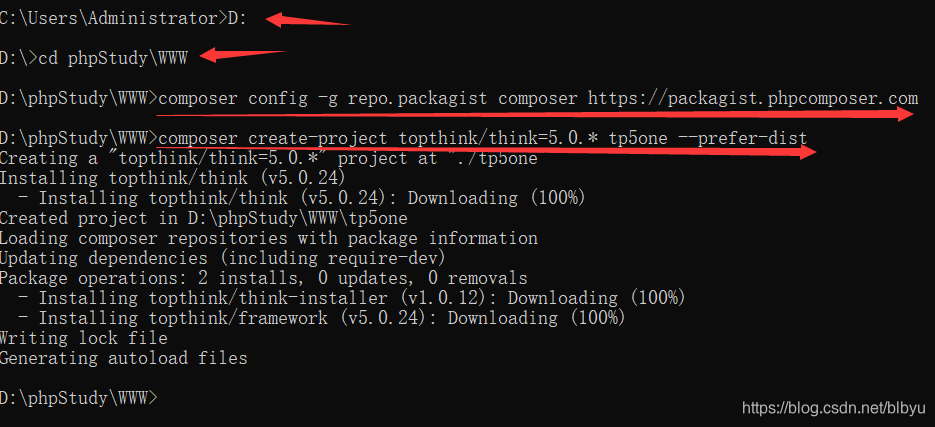如何使用composer下载tp5(5.0.24)框架
本文共 512 字,大约阅读时间需要 1 分钟。
第一步:https://www.phpcomposer.com内下载最新composer版本
第二步:安装composer.exe,傻瓜式点点点(注意选择正确的php.exe) 第三步:运行命令提示符,输入“composer”检测是否安装成功,若成功可以看到如下内容, 接着,定位到tp5的安装目录,并下载最新版本tp。
接着,定位到tp5的安装目录,并下载最新版本tp。 为了避免安装过慢,可以使用阿里云的 composer 镜像:composer config -g repo.packagist composer https://packagist.phpcomposer.com。 最后,composer create-project topthink/think=5.0.* tp5 --prefer-dist表示下载安装最新的5.0版本,tp5为文件夹名称。
为了避免安装过慢,可以使用阿里云的 composer 镜像:composer config -g repo.packagist composer https://packagist.phpcomposer.com。 最后,composer create-project topthink/think=5.0.* tp5 --prefer-dist表示下载安装最新的5.0版本,tp5为文件夹名称。 2020/8/31 若使用composer下载thinkphp时报错无法从相应地址里获取源数据,则可以更新url(非官方手册所提供的阿里云地址):
composer config -g repo.packagist composer https://mirrors.aliyun.com/composer/转载地址:http://bxum.baihongyu.com/
你可能感兴趣的文章
nginx代理地图服务--离线部署地图服务(地图数据篇.4)
查看>>
Nginx代理外网映射
查看>>
Nginx代理模式下 log-format 获取客户端真实IP
查看>>
Nginx代理解决跨域问题(导致图片只能预览不能下载)
查看>>
Nginx代理配置详解
查看>>
Nginx代理静态资源(gis瓦片图片)实现非固定ip的url适配网络环境映射ip下的资源请求解决方案
查看>>
Nginx代理静态资源(gis瓦片图片)实现非固定ip的url适配网络环境映射ip下的资源请求解决方案
查看>>
nginx反向代理
查看>>
nginx反向代理、文件批量改名及统计ip访问量等精髓总结
查看>>
Nginx反向代理与正向代理配置
查看>>
Nginx反向代理及负载均衡实现过程部署
查看>>
Nginx反向代理是什么意思?如何配置Nginx反向代理?
查看>>
nginx反向代理解决跨域问题,使本地调试更方便
查看>>
Nginx反向代理配置
查看>>
Nginx启动SSL功能,并进行功能优化,你看这个就足够了
查看>>
nginx启动脚本
查看>>
Nginx在Windows上和Linux上(Docker启动)分别配置基本身份认证示例
查看>>
Nginx在Windows下载安装启动与配置前后端请求代理
查看>>
Nginx多域名,多证书,多服务配置,实用版
查看>>
nginx如何实现图片防盗链
查看>>